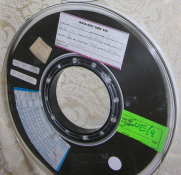The only way of getting negatives on reversal film with the black rebates is if each frame is exposed separately, There were Leitz and other 35mm contact printers and other copy apparatus for optical copying.
Ian
Ian
We are not at the movie industry, but at some amateur(?) darkroom, likely in the 30s.
Frankly, after thinking it over, I don't think any of them are copies; I think they are all originals, but I won't trot out any more speculations, as it tends to cloud the original intent of the post, we have chewed this to death and won't likely agree anyway.
The ones with the black rebates can't be originals there's no negative process where that's possible except by copying onto reversal film frame by frame. It would also be easy to explain if the original was deteriorating so was copied then disposed of.
Ian

Not true. The negative could have been lightly fogged prior to intensification.
Look, Ian, your's is a plausible explanation. I am not debating that, but it's not the only possible explanation, and I have a strong suspicion due to the color of the emulsion it the negatives in question were chemically toned to intensify them and not copied.
There's no possibility of "lightly fogging prior to intensification" this just doesn't happen, yes intensification can cause an overall base staining but anything that causes the rebates to go from clear unexposed (so undeveloped) and fixed to a high Dmax would destroy the image entirely.
We know from the OP that negatives have been marked for Intensification and Reduction and that's reflected in the varying negative colours referred to.
Ian








These are spectacular. Well done to both the original photographer and you for reviving them!! I love seeing pictures of an older world, one that has disappeared forever. Now you have encouraged me to look at some of my father's negatives from the 1930s and 1940s. If you cannot revive your scanner, I suggest one of the Plustek models, such as the 8200i. It is possibly marginally poorer than the Nikon, but comes with Silverfast Ai software.
Something to consider: Here you have showed us pictures taken 80 years ago. Will our descendants be able to view our 80-year-old digital files? You really think so? I worked at a US Government research lab with professional IT support, and we often could not read media only 15 years old (such as VAX/VMS 4mm DAT backup tapes).

I do not, perhaps we can find out by measuring the exact frame size, and length between frames?Great images. Any idea what camera he was using?








I do not, perhaps we can find out by measuring the exact frame size, and length between frames?
I don't think there were many 35mm camera's at this time? most was 120. Given the quality, Leica?









Strange is that at the end of role 7 we suddenly take pictures in the Netherlands?





Currently scanning the last roll.
Limbo

...





| Photrio.com contains affiliate links to products. We may receive a commission for purchases made through these links. To read our full affiliate disclosure statement please click Here. |
PHOTRIO PARTNERS EQUALLY FUNDING OUR COMMUNITY:  |